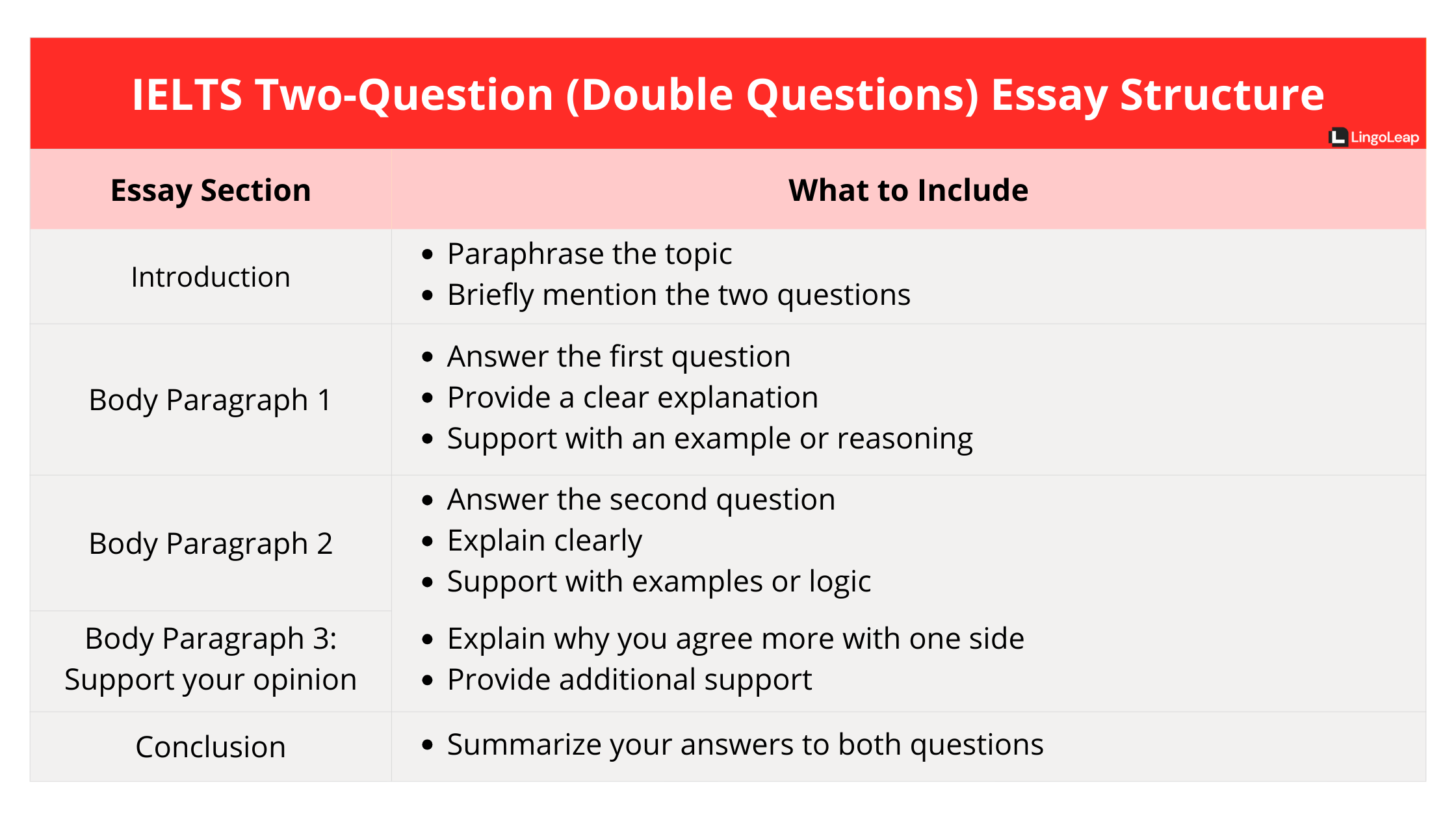IELTS Writing Task 2: Double-Question Essay Guide
What is a Double-Question Essay?
A Double-Question essay—also called a "Two-Part Question"—asks you to answer two separate questions related to the same topic. Unlike Discussion or Opinion essays, these prompts don’t ask you to weigh two opposing views or take a side. Instead, you must address each question directly and equally.
You will typically see an introductory statement followed by:
Why is this the case?
What are the effects?
Or:
What are the reasons for this trend?
Is this a positive or negative development?
What Makes Double-Question Essays Tricky?
The main challenge is making sure you answer both questions fully. Many candidates write only about one question or write too much about one and neglect the other. Another issue is confusion with other IELTS essay types, especially:
- Advantages and Disadvantages: These ask you to discuss pros and cons of one issue, while Double Questions may ask for causes and personal opinions.
- Problem-Solution: These always ask for a problem and a solution. Double Question essays may ask for reasons and effects, or opinion-based answers.
- Opinion (Agree/Disagree): Those ask you to choose a side. In Double Questions, you are not taking sides but answering two separate issues.
- Discussion: These ask you to discuss two views and give your opinion. Double Questions usually don’t involve contrasting perspectives.
Common Structures of Double Question Essays
The most common structure involves one paragraph per question, but sometimes three body paragraphs can be used for better development. You must treat each question as equally important.
📌 Recommended Structure
- Introduction
- Paraphrase the topic
- Briefly mention the two questions
- Body Paragraph 1: Answer the first question
- Provide a clear explanation
- Support with an example or reasoning
- Body Paragraph 2: Answer the second question
- Explain clearly
- Support with examples or logic
- Conclusion:
- Summarize your answers to both questions

How to Analyze and Answer Each Question
Most Double Question essays follow a predictable format. Here's how to approach each kind:
1. Reason + Effect / Problem
- Question 1: Why is this happening? → Think about causes, trends, or motivations (economic, social, technological, etc.).
- Question 2: What is the impact? → Discuss possible consequences—positive or negative—on individuals or society.
2. Reason + Opinion
- Question 1: Why is this the case? → Focus on giving 1–2 strong reasons with explanations.
- Question 2: Do you think this is good or bad? → Give a clear opinion and justify it logically.
3. Problem + Personal View
- Question 1: What is the main issue? → State the problem with context and examples.
- Question 2: What should individuals or governments do? → Suggest actions or policies. You don’t need to propose full solutions—just practical ideas.
Key Writing Tips
- ✅ Make sure you clearly address each question
- ✅ Use topic sentences to make your answers obvious
- ✅ Don’t mix your answers between paragraphs
- ✅ Avoid general statements—be specific and logical
- ✅ Don’t give only pros/cons or only solutions if that’s not what the question asks
Band Descriptors for Double-Question Essays
- Task Response: Did you fully address both questions with relevant ideas?
- Coherence & Cohesion: Are your two body paragraphs clearly separated and logically developed?
- Lexical Resource: Are you using topic-specific and varied vocabulary?
- Grammatical Range & Accuracy: Are you using a mix of complex and simple sentence structures without major errors?
👉 More details here: IELTS Band Descriptors Guide
Practice Smarter with LingoLeap 🚀
Double Question essays test your ability to break down complex tasks. With LingoLeap, you can:
- ✅ Get real IELTS double-question prompts
- ✅ Receive instant scoring and AI-powered feedback
- ✅ Improve your ideas, grammar, and clarity—all in one place
🎓 Try it free now👉 Start practicing on LingoLeap